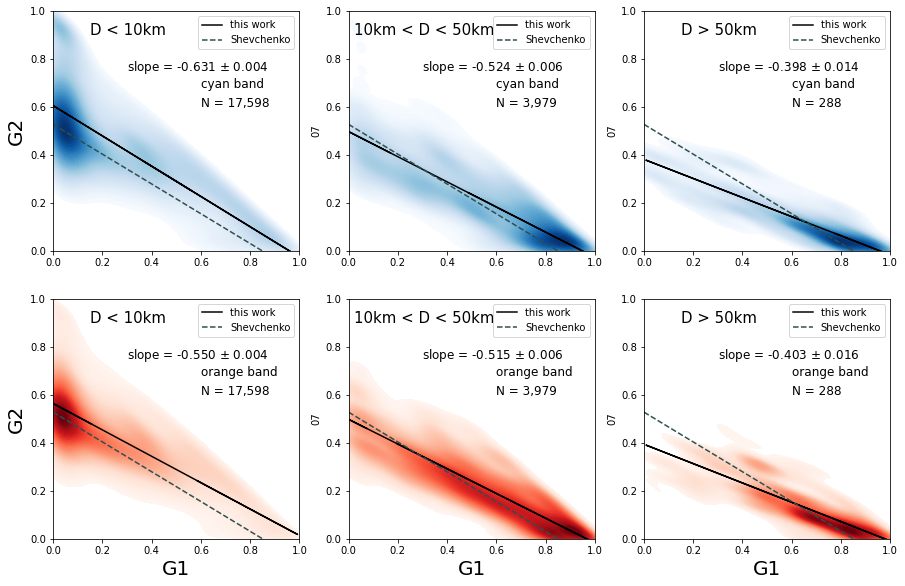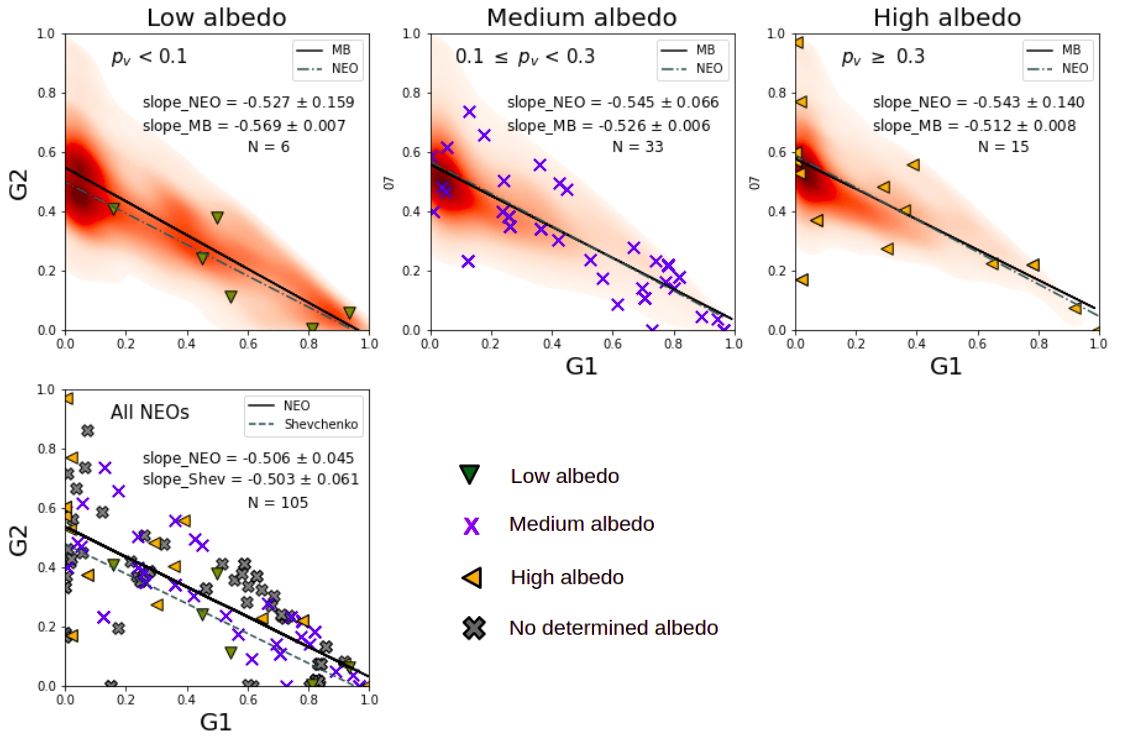- 1Observatório Nacional, Rua Gal. José Cristino 77, 20921-400 Rio de Janeiro, Brazil.
- 2INAF - Osservatorio Astronomico di Roma, via Frascati 33, I-00078 Monteporzio Catone (Roma), Italy.
- 3Universidade de São Paulo, IAG, Rua do Matão 1226, Cidade Universitária, 05508-090 São Paulo, Brasil.
- 4Instituto de Astrofísica de Canarias (IAC), C/Vía Láctea sn, 38205 La Laguna, Spain.
Introduction
The observation of NEOs allows us to study the physical characteristics of the smallest size bodies of our Solar System as well as to impose constraints on their origin and evolution. Considering that these objects are in unstable orbits over the age of the Solar System, this implies that it is a transient population, which can be asteroids or comets, forming a particularly interesting population to study [1,2]. Important physical properties of atmosphereless bodies can be derived from their phase curves which represent how the object’s brightness varies with the solar phase angle. These properties are based on the understanding that the physical properties of the material present on the object’s surface can be retrieved from the analysis of the scattering of the incident solar radiation. Therefore, we set up an observational campaign in order to determine the phase curve for a large number of NEOs, deriving their absolute magnitude, H, and the G1 and G2 parameters. Together, these two parameters can provide information about composition, texture, and roughness properties [3].
Observations and results
In order to obtain the physical parameters of NEOs, we set up an observational campaign since 2017 to derive phase curves of these objects. Considering all objects observed in our campaign, taken from works [4,5,6] and Arcoverde et al., (submitted), we analyzed a homogeneous dataset of 32 NEOs. The data were mainly acquired at the Astronomical Observatory of Sertão de Itaparica (Brazil), with some NEOs also observed at the Osservatorio di Campo Imperatore (Italy). Then, using data from the dual-band photometry phase curves of NEOs and MB, acquired by the Asteroid Terrestrial-impact Last Alert System Survey [7,8] telescopes, we analyzed the behavior in G1 vs G2 of 21,865 MB and 105 NEOs. The objects were separated into three bands of albedo - low, medium and high - and three bands of diameter - less than 10 km, greater than 10 km, but less than 50 km and greater than 50 km.
Analyzing the large sample of MB, we found evidence that the distribution in phase space G1 - G2 has a strong dependence not only on the albedo but also on the size of the object, as shown in figure 1. Objects with D > 10km correspond to the behavior expected [9], and occupy specific regions in the phase space according to the albedo.

Figure 1: G1, G2-distributions for three diameter ranges of MB objects, from the ATLAS dual-band photometry asteroid phase curve catalog, observed in cyan (blue adjustment) and orange (red adjustment). The black line corresponds to the linear fit of the sample with the slop value shown, and the dashed line corresponds to the linear fit with the 93 MB of work [9], for comparison.
This size dependence on the G1 - G2 phase space is particularly true for smaller objects. As our NEOs are an even smaller population than the MB's, we cannot estimate the albedo of small objects from their phase curve parameters, as shown in Figure 2, from the distribution of our 105 NEOs in the G1 - G2 phase space. Obviously, a larger dataset of very small MB objects is needed to confirm whether the behavior mentioned above is specific to NEOs or to all very small bodies in the Solar System.

Figure 2 : G1, G2-pairs for MB 𝐷 < 10km with three albedo ranges for all NEOs with determined albedo (upper panels), and for all 105 NEO sample (bottom panel). The black line indicate the linear fits to the MB data and the dashed line indicate the linear fits to the NEO.
Acknowledgements
P.A., E.R., F.M., M.E, W.P. and J.M. would like to thank CNPq, FAPERJ and CAPES for their support through diverse fellowships. Support by CNPq (310964/2020-2) and FAPERJ (E-26/202.841/2017 and E-26/201.001/2021) is acknowledged by D.L. The authors are grateful to the IMPACTON team, in special to R. Souza, A. Santiago and J. Silva for the technical support.
References
[1] Bottke, W.F., Morbidelli, A., Jedicke, R., Petit, J.M., Levison, H.F., Michel, P., Metcalfe, T.S., 2002. . Icarus 156, 399–43.
[2] Morbidelli, A., Walsh, K.J., O’Brien, D.P., Minton, D.A., Bottke, W.F., 2015. pp. 493–507
[3] Helfenstein, P., Veverka, J., 1989. Asteroids II, University of Arizona Press, Tucson, pp. 557–593
[4] Rondón, E., Arcoverde, P., Monteiro, F., Medeiros, H., Navas, G., Lazzaro, D., Carvano, J.M., Rodrigues, T., 2019. 484, 2499–2513
[5] Rondón, E., Lazzaro, D., Carvano, J., Monteiro, F., Arcoverde, P., Evangelista, M., Michimani, J., Mesquita, W., Rodrigues, T., 2022. 372, 114723.
[6] Ieva, S., Arcoverde, P., Rondón, E., Giunta, A., Dotto, E., Lazzaro, D., Mazzotta Epifani, E., Perna, D., Fanasca, C., Rodrigues, T., Monteiro, F., Medeiros, H., Silva-Cabrera, J.S., Di Paola, A., 2022.
[7] Mahlke, M., Carry, B., Denneau, L., 2021. 354, 114094.
[8] Tonry, J.L., Denneau, L., Flewelling, H., Heinze, A.N., Onken, C.A., Smartt, S.J., Stalder, B., Weiland, H.J., Wolf, C., 2021. VizieR Online Data Catalog , J/ApJ/867/105.
[9] Shevchenko, V.G., Belskaya, I.N., Muinonen, K., Penttilä, A., Krugly, Y.N., Velichko, F.P., Chiorny, V.G., Slyusarev, I.G., Gaftonyuk, N.M., Tereschenko, I.A., 2016. . 123, 101–11
How to cite: Arcoverde, P., Rondón, E., Monteiro, F., Pereira, W., Ieva, S., Lazzaro, D., Michtchenko, T., Evangelista, M., Michimani, J., Mesquita, W., Corrêa, T., Dotto, E., Giunta, A., Di Paola, A., Medeiros, H., Carvano, J. M., and Rodrigues, T.: Physical properties of NEOs derived from their phase curves, Europlanet Science Congress 2022, Granada, Spain, 18–23 Sep 2022, EPSC2022-746, https://doi.org/10.5194/epsc2022-746, 2022.

